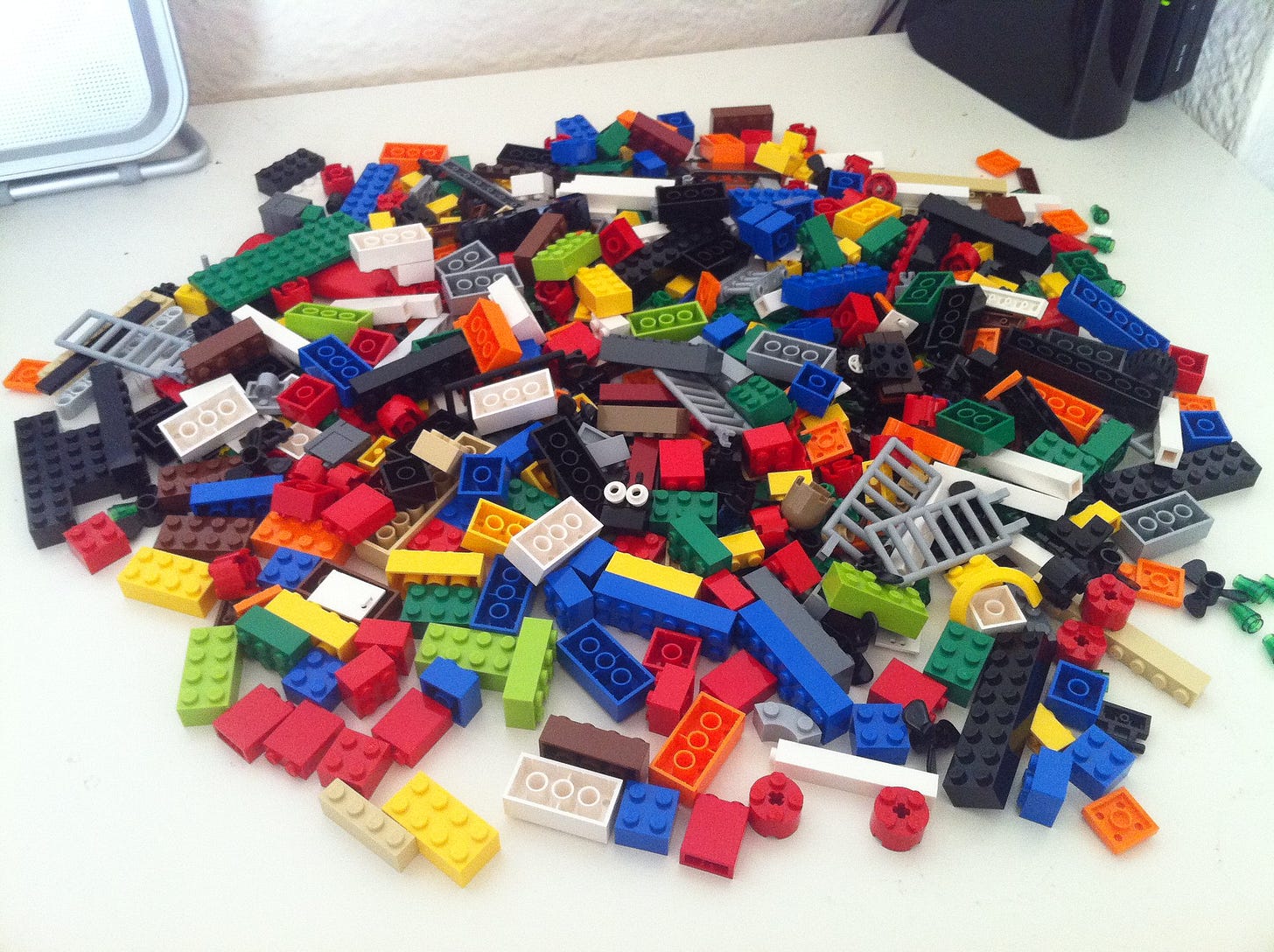This is Andrew Benedict-Nelson, social change strategist and innovation educator. Each week, I share a question that you and your organization can use to find a new perspective on the toughest problems you face. Reply to the e-mail or comment on the site and we can talk about them together!
NOW FOR THIS WEEK’S QUESTION…
Pretend that your problem is a perfectly constructed model made of Lego bricks or any similar toy. Now imagine that a toddler comes through the room and not only smashes it to bits, but mixes it in with a bunch of his other toys. To reconstruct the model, you’ll first need to identify the parts. What are the essential components of your problem? What parts make it distinct, and what does that mean for your efforts to solve it?
My kid isn’t into Legos yet, but the inspiration for this exercise definitely came from a chaotic toy experience at home. And I find it works best if you have some sort of visual or material inspiration to work with. Just take anything organized in your world and dump it out on a table or the floor. It can be your silverware drawer, your sock drawer, your pet rock collection, anything with structure. Mess it up.
When the structure disappears, what sticks out? Even if the objects are actually blocks or socks or spoons, pick them up and name them after parts of your problem. What components of the problem naturally emerge in your mind? Are some components associated with certain colors or qualities? Do you need to mark certain parts of the problem as distinctive or special? Why?
Concrete exercises like this can bring out strong feelings, so if that is happening to you, take some time to process those first. Then follow these steps to gain insight into your problem.
HOW TO DO IT
Take inventory: The first step is listing the components. The list-making part of this exercise can go on forever, so you might limit yourself by saying something like “No more than twelve components” or setting a five-minute timer. It is highly likely that you’ll revise your component list as you move through the exercise, so all you have to do is list enough to get started.
One of these things is not like the other: Remember, you have to differentiate the components of your problem from the other toys in the room (or objects in the kitchen, or clothing in the drawer, etc.) How do you know when a component belongs to your problem in particular? Are there parts that only belong to your problem, or do they also show up elsewhere? Are there pieces that clearly do not belong? Try to figure out what principles distinguish parts of your problems from everything else in the room.
This and that: Do the parts of your problem naturally fall into different categories? Could there even be more than one way to categorize them? Consider why these categories exist and what they might mean for the way you approach your problem. If these categories emerge from the objects you are using for the exercise, that's okay too. For example, you may find that Lego people mean something different in the world of your problem from Lego bricks — why did you divide up the problem in that way?
Start over: If you have time, try doing the first three steps again without repeating any of the components of the problem you used the first time. This can be very challenging and you may realize you are describing a completely different but related problem.
Put it back together: Take a moment to put the demolished problem back together in your mind. Look at it the way you looked at it before the toddler came into the room and took everything apart. What looks different now that you have seen all the part of the problem laid out individually? Are there parts you value more or less now? Do you understand the relationships among them differently?
A bonus activity: My favorite moment playing with Legos as a kid came after I finished the vehicle or structure depicted on the box, then took it apart to start imagining my own. Can you imagine the components of your problem fitting together in a different way or mixing with components from other problems? This can lead to all sorts of creative outcomes, but make sure you don’t do it prematurely, since you want to understand your original assumptions about the problem before you start changing too much.
CAN YOU GIVE ME AN EXAMPLE?
We didn’t use this exact exercise, but this mode of thinking reminds me of a project that Insight Labs did with the U.S. State Department. We were looking at new ways for the United States to support civil society abroad. Because of the number of participants in the exercise, we broke into small groups and assigned each one a different component of civil society. The imagined solutions looked so different based on each area considered that one of the insights that came away from the session was "Don't assume there is a generalized approach to civil society.” You may reach similar conclusions as you consider the parts of your problem one by one.
COOL, SO WHAT MAKES THIS WORK?
This question is an example of how to view your problem in new ways using the configuration dynamic. It’s one of six innovation dynamics I help people master to improve their critical thinking and build strategies for social change. Reply to this e-mail with your answer to the question and I’ll let you know what I think! Or learn more by visiting http://www.teachingsocialchange.com.
Illustration via justgrimes on Flickr. Creative Commons license.



